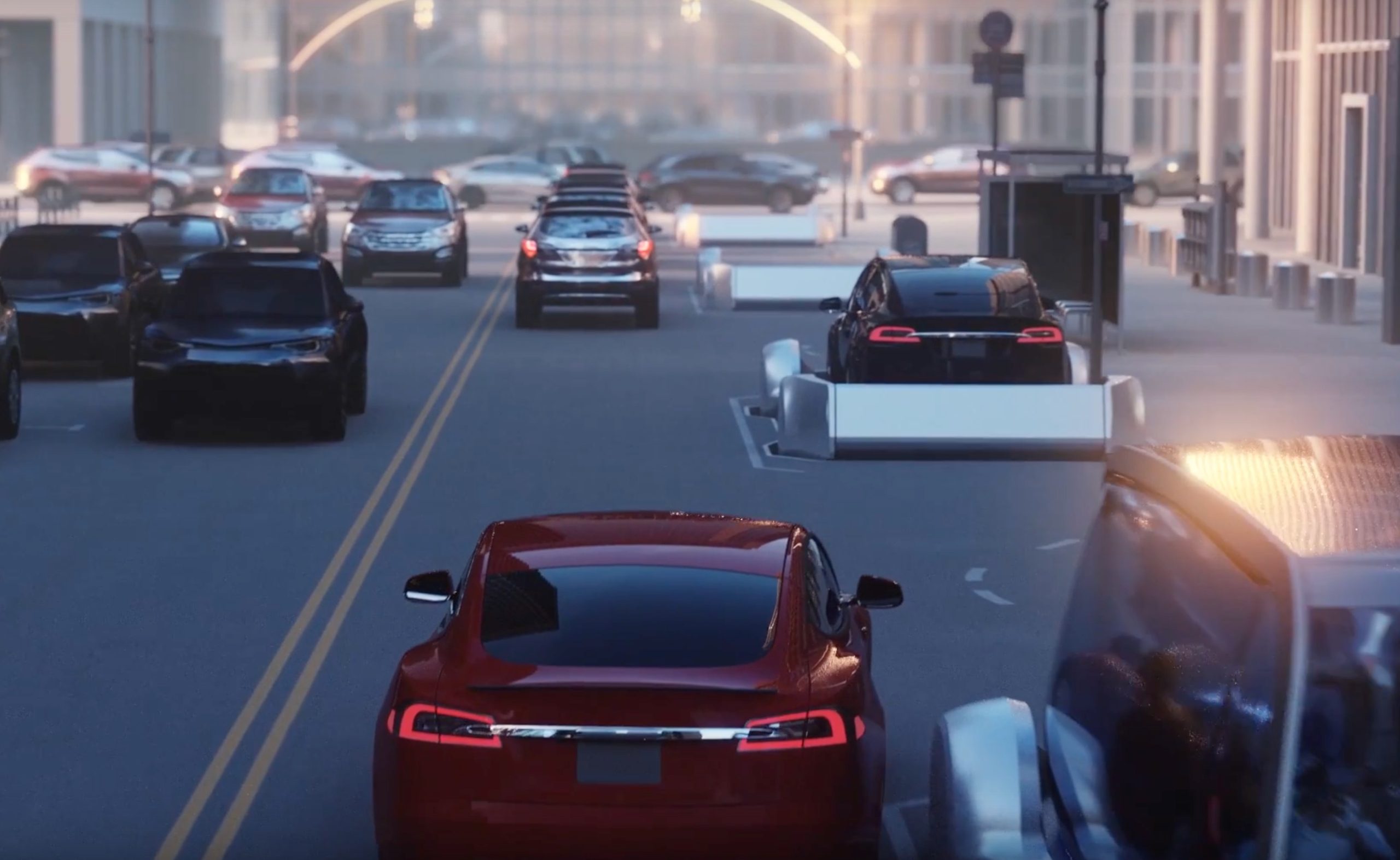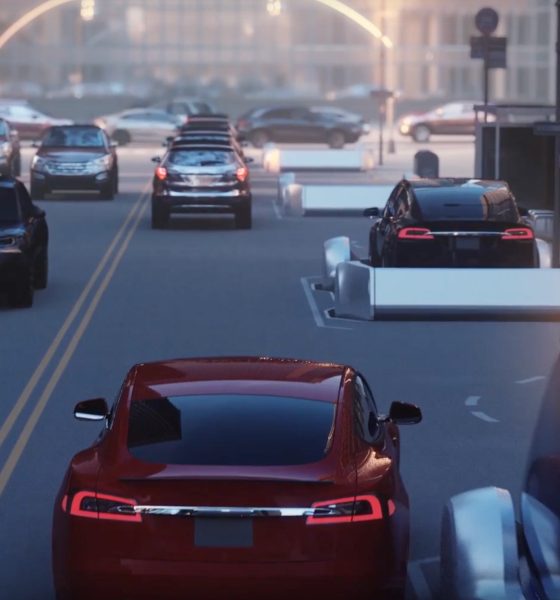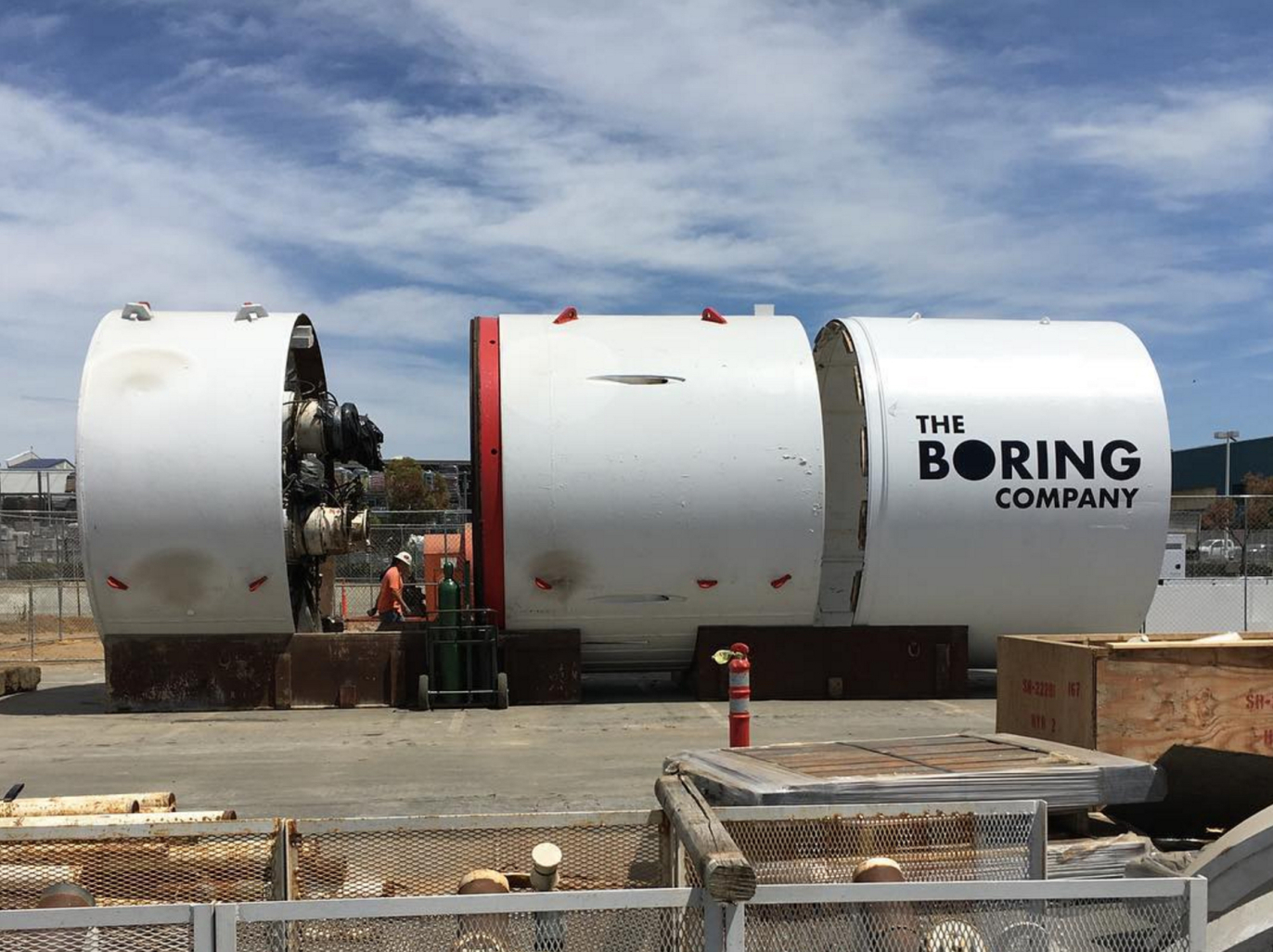

News
Musk outlines cost-cutting plan for Boring Co: cheaper, faster tunnel digging
One of the large reveals made by Tesla and SpaceX Chief Elon Musk at TED2017 was his plan to create a multi-layer high-speed tunnel infrastructure to support mobility by way of electric skates and Hyperloop tubes.
A key point that he drove home for the underground tunnel network was the integration of the system into cities.
“You have to be able to integrate the entrance and exit of the tunnel seamlessly into the fabric of the city. So, by having an elevator, sort of a car skate that is on an elevator, you can integrate the entrance and exits to the tunnel network just by using 2 parking spaces.”
Musk shared a video demonstrating how skate elevators would be integrated into city streets where they await vehicles looking to be transported through the underground labyrinth of tunnels. The serial tech entrepreneur envisions loading docks wherein vehicles would simply pull into the skate, get lowered into the tunnel network, and be sent along a slot car-like track at speeds of 200 km/h ( 124 mph). The Boring Company’s tunnel network won’t simply alleviate surface congestion, it will completely transform the way we move cars, people and freight, says Musk.
It is worth noting that The Boring Company and Tesla are under control of Musk, while the Hyperloop project has been open sourced, but with support from SpaceX.
Eliminating human drivers allows the skates to move at much faster speeds than human-controlled vehicles. Fixed routes within the tunnel network further improve safety beyond the dynamic nature of human-determined driving routes. The tunnel network is also infinitely scalable. “You can alleviate any arbitrary level of open congestion with a 3D tunnel network.” and that “There’s no real limit to how many levels of tunnels you can have.”, says Musk from TED2017.
The key barrier to creating tunnels today is the exorbitant cost. The recent 2.5 mile expansion to the Los Angeles subway system came at a cost of nearly $1 billion per mile. Musk and team at the Boring Company hope to cut the cost of tunneling by a significant amount by streamlining the tunneling process and reinventing the machines that help facilitate the digging.
https://www.youtube.com/watch?v=u5V_VzRrSBI
Building Tunnels For Less
First, the team is looking to cut the diameter of the tunnels they dig, moving from the traditional tunnel diameter for passenger vehicles of 26 to 28-feet to a 12-foot standard diameter which would be sufficient for the Tesla skate. On the surface, this might not seem like a lot, but cutting the diameter by 50% cuts the cross sectional area by a factor of four. This is significant as the speed and cost of tunneling is largely driven by the amount of cross sectional area to dig. Being able to cut out 75% of the time associated with digging comes with enormous cost savings.
Second, the team plans to attack head-on the way tunneling machines currently dig. Traditional machines dig, slowly and incrementally, then stop to install reinforcements to support the newly exposed earthen walls. Musk and team are working to install the reinforcements continuously thus eliminating the need to pause operations. This integration is expected to increase the speed of the overall process by as much as 50%.

The Boring Company tunneling machine spotted in front of SpaceX in April, 2017
Finally, the team believes that current digging machines are nowhere near their power and thermal limits, and is looking to ‘jack up the power’ to the digging machines. Doing this, the team hopes to increase the speed by a factor of 4 or 5 on top of the other improvements being suggested by Musk.
Musk also revealed that The Boring Company has a pet snail named Gary who can currently travel at 14 times the speed of existing tunneling machines. While this is more a testament about how slow the boring process is than the amazing speed of Gary, it is a fun target for the team, to be able to build tunnels quicker than Gary can crawl, and continues the comedic spin on the new company.
These tunnels could be kept at or near a vacuum to reduce or eliminate air resistance for all the moving objects within it. Curiously, Musk shared that,
“To withstand the water table, you have to design a wall to be able to withstand 5 or 6 atmospheres. To go to vacuum, you only need to be able to withstand 1 atmosphere.”
It is clear that Musk is very excited about this new Boring Company. He indicated during his sit down at TED2017 that he spends 2-3% of his time on the project, noting that it’s essentially being run as not much more than an intern project with a used boring machine and a few people dedicating partial effort to it.

News
Tesla FSD fleet is nearing 7 billion total miles, including 2.5 billion city miles
As can be seen on Tesla’s official FSD webpage, vehicles equipped with the system have now navigated over 6.99 billion miles.

Tesla’s Full Self-Driving (Supervised) fleet is closing in on almost 7 billion total miles driven, as per data posted by the company on its official FSD webpage.
These figures hint at the massive scale of data fueling Tesla’s rapid FSD improvements, which have been quite notable as of late.
FSD mileage milestones
As can be seen on Tesla’s official FSD webpage, vehicles equipped with the system have now navigated over 6.99 billion miles. Tesla owner and avid FSD tester Whole Mars Catalog also shared a screenshot indicating that from the nearly 7 billion miles traveled by the FSD fleet, more than 2.5 billion miles were driven inside cities.
City miles are particularly valuable for complex urban scenarios like unprotected turns, pedestrian interactions, and traffic lights. This is also the difference-maker for FSD, as only complex solutions, such as Waymo’s self-driving taxis, operate similarly on inner-city streets. And even then, incidents such as the San Francisco blackouts have proven challenging for sensor-rich vehicles like Waymos.
Tesla’s data edge
Tesla has a number of advantages in the autonomous vehicle sector, one of which is the size of its fleet and the number of vehicles training FSD on real-world roads. Tesla’s nearly 7 billion FSD miles then allow the company to roll out updates that make its vehicles behave like they are being driven by experienced drivers, even if they are operating on their own.
So notable are Tesla’s improvements to FSD that NVIDIA Director of Robotics Jim Fan, after experiencing FSD v14, noted that the system is the first AI that passes what he described as a “Physical Turing Test.”
“Despite knowing exactly how robot learning works, I still find it magical watching the steering wheel turn by itself. First it feels surreal, next it becomes routine. Then, like the smartphone, taking it away actively hurts. This is how humanity gets rewired and glued to god-like technologies,” Fan wrote in a post on X.
News
Tesla starts showing how FSD will change lives in Europe
Local officials tested the system on narrow country roads and were impressed by FSD’s smooth, human-like driving, with some calling the service a game-changer for everyday life in areas that are far from urban centers.

Tesla has launched Europe’s first public shuttle service using Full Self-Driving (Supervised) in the rural Eifelkreis Bitburg-Prüm region of Germany, demonstrating how the technology can restore independence and mobility for people who struggle with limited transport options.
Local officials tested the system on narrow country roads and were impressed by FSD’s smooth, human-like driving, with some calling the service a game-changer for everyday life in areas that are far from urban centers.
Officials see real impact on rural residents
Arzfeld Mayor Johannes Kuhl and District Administrator Andreas Kruppert personally tested the Tesla shuttle service. This allowed them to see just how well FSD navigated winding lanes and rural roads confidently. Kruppert said, “Autonomous driving sounds like science fiction to many, but we simply see here that it works totally well in rural regions too.” Kuhl, for his part, also noted that FSD “feels like a very experienced driver.”
The pilot complements the area’s “Citizen Bus” program, which provides on-demand rides for elderly residents who can no longer drive themselves. Tesla Europe shared a video of a demonstration of the service, highlighting how FSD gives people their freedom back, even in places where public transport is not as prevalent.
What the Ministry for Economic Affairs and Transport says
Rhineland-Palatinate’s Minister Daniela Schmitt supported the project, praising the collaboration that made this “first of its kind in Europe” possible. As per the ministry, the rural rollout for the service shows FSD’s potential beyond major cities, and it delivers tangible benefits like grocery runs, doctor visits, and social connections for isolated residents.
“Reliable and flexible mobility is especially vital in rural areas. With the launch of a shuttle service using self-driving vehicles (FSD supervised) by Tesla in the Eifelkreis Bitburg-Prüm, an innovative pilot project is now getting underway that complements local community bus services. It is the first project of its kind in Europe.
“The result is a real gain for rural mobility: greater accessibility, more flexibility and tangible benefits for everyday life. A strong signal for innovation, cooperation and future-oriented mobility beyond urban centers,” the ministry wrote in a LinkedIn post.
News
Tesla China quietly posts Robotaxi-related job listing
Tesla China is currently seeking a Low Voltage Electrical Engineer to work on circuit board design for the company’s autonomous vehicles.

Tesla has posted a new job listing in Shanghai explicitly tied to its Robotaxi program, fueling speculation that the company is preparing to launch its dedicated autonomous ride-hailing service in China.
As noted in the listing, Tesla China is currently seeking a Low Voltage Electrical Engineer to work on circuit board design for the company’s autonomous vehicles.
Robotaxi-specific role
The listing, which was shared on social media platform X by industry watcher @tslaming, suggested that Tesla China is looking to fill the role urgently. The job listing itself specifically mentions that the person hired for the role will be working on the Low Voltage Hardware team, which would design the circuit boards that would serve as the nervous system of the Robotaxi.
Key tasks for the role, as indicated in the job listing, include collaboration with PCB layout, firmware, mechanical, program management, and validation teams, among other responsibilities. The role is based in Shanghai.
China Robotaxi launch
China represents a massive potential market for robotaxis, with its dense urban centers and supportive policies in select cities. Tesla has limited permission to roll out FSD in the country, though despite this, its vehicles have been hailed as among the best in the market when it comes to autonomous features. So far, at least, it appears that China supports Tesla’s FSD and Robotaxi rollout.
This was hinted at in November, when Tesla brought the Cybercab to the 8th China International Import Expo (CIIE) in Shanghai, marking the first time that the autonomous two-seater was brought to the Asia-Pacific region. The vehicle, despite not having a release date in China, received a significant amount of interest among the event’s attendees.








